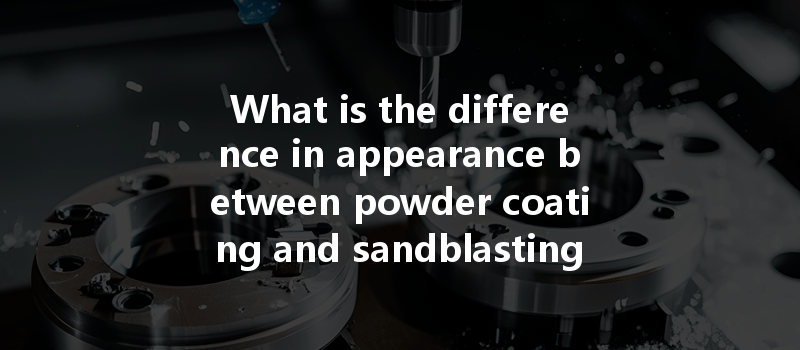: An Eye-Catching Start
Did you know that nearly 70% of consumers decide whether to purchase a product based solely on its appearance? In today’s competitive market, aesthetics can make or break a product’s success. Whether you’re manufacturing intricate parts through CNC machining or simply trying to enhance the appeal of a final product, surface treatments play a critical role. Among the myriad of options available, powder coating and sandblasting are two of the most popular methods used to enhance surface quality and performance. This comprehensive guide will delve into the differences between these two surface treatment methods, focusing primarily on their appearance, applications, and overall effectiveness.
Chapter 1: Understanding Surface Treatments
Before diving into the specifics of powder coating and sandblasting, it’s essential to understand what surface treatments are and why they are significant in CNC machining.
Surface treatments are processes applied to a part after fabrication to improve its physical properties, enhance its durability, and make it visually appealing. Whether it’s for aesthetic reasons, to increase corrosion resistance, or to prepare a surface for further machining, these treatments are a fundamental aspect of the manufacturing process.
Chapter 2: What is Powder Coating?
Powder coating is a finishing process that involves applying a dry powder to a surface, which is then cured under heat to create a hard, protective coating. It is commonly used for metal surfaces but can also be applied to various materials.
2.1 The Process of Powder Coating
2.2 Appearance and Finish
Powder coating provides a wide variety of finishes that can include matte, glossy, and textured looks. The depth of color and finish is often richer than traditional liquid paints, resulting in a more visually appealing surface. Additionally, powder-coated surfaces are known for their uniformity, offering a smooth look without visible brush strokes or drips.
Chapter 3: What is Sandblasting?
Sandblasting, also known as abrasive blasting, involves propelling abrasive materials at high velocity to clean, smooth, or engrave a surface. This method is especially useful for preparing surfaces for further treatment or enhancing surface texture.
3.1 The Process of Sandblasting
3.2 Appearance and Finish
The finish of sandblasted surfaces is typically more textured than that of powder-coated surfaces. The degree of roughness can vary depending on the abrasive used, leading to a pebbly or matte appearance that can greatly enhance grip or adhesion for subsequent coatings.
Chapter 4: Key Differences in Appearance
While both methods are effective in enhancing surfaces, they produce distinctly different appearances.
4.1 Color and Gloss
Powder coating can achieve vibrant colors with high gloss levels, giving the product a polished look, whereas sandblasting tends to create a more muted, rugged texture. If your design requires bright colors and a shiny finish, powder coating is the way to go.
4.2 Surface Texture
The texture results from the original surface of the part, the blasting media used, and the application method. Sandblasted surfaces usually have more pronounced texture, making them ideal for products that require friction for handling or assembly.
4.3 Uniformity

Powder coating allows for a more uniform finish; there are fewer visible imperfections than with sandblasted surfaces, where tiny imperfections can be more visible depending on the angle of light and the surface texture.
Chapter 5: When to Use Which Method
The choice between powder coating and sandblasting often depends on the desired outcome and specific project requirements.
5.1 Use Powder Coating When:
5.2 Use Sandblasting When:
Chapter 6: Environmental and Practical Considerations
As both methods have their pros and cons, understanding their environmental impact and practicality is crucial in making the right decision.
6.1 Environmental Impact
Both powder coating and sandblasting have varying environmental impacts. Powder coating can produce some VOC (volatile organic compounds) if not managed properly, while sandblasting creates dust and potential pollutant emissions if proper containment and vacuum systems are not in place.
6.2 Equipment and Costs
The equipment for powder coating tends to be more complex and costly than that for sandblasting. However, if a project requires many color changes or requires high production demands, the investment can pay off.
Chapter 7: Real-World Applications
To understand the applicability of both treatments, let’s explore some real-world examples where powder coating and sandblasting shine in industry.
Chapter 8:
As we bring this extensive discussion to a close, it’s clear that both powder coating and sandblasting serve unique purposes within the realm of CNC machining. Their distinct appearances not only enhance the aesthetic value but also significantly impact the performance of the final product. Understanding the strengths and limitations of each method allows manufacturers and designers to make informed decisions that can lead to greater product success.
In summary, if your project runs parallel to these three themes—durability, aesthetics, cost-effectiveness—ensure that you balance the appearances achieved through either powder coating or sandblasting with the functional requirements of the application.
As industries continue to demand both quality and aesthetic appeal, the choice of surface treatment will undoubtedly remain a topic of importance.
Final Thought
This blog serves as a comprehensive lens through which to examine and appreciate the vital role of surface treatments in manufacturing. As you consider your next product design or CNC machining project, the information shared here is not just food for thought, but a guide to implementing designs that are as visually appealing as they are effective. What will your next surface treatment choice be?






